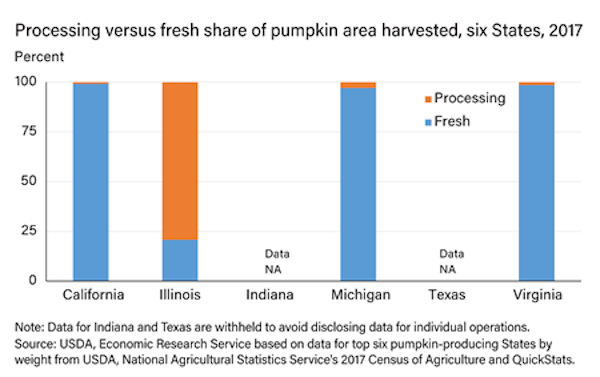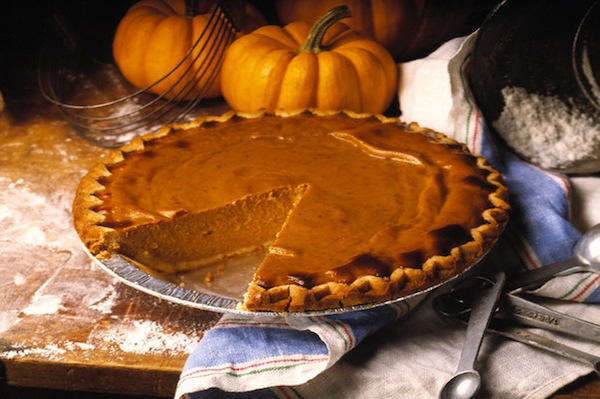Before becoming the iconic Autumn symbol it is today, the pumpkin was often a food of last resort for early American settlers. The colonists learned how to grow the squash from Native Americans, who considered it one of the “three sisters,” along with corn and beans. They would grow the squash along river banks next to maize and beans, a planting technique that was called the “Three Sisters Method,” which allowed the three crops to sustain each other. Corn served as the trellis upon which the beans could climb; beans were nourished by the sunlight and kept the corn stalks stable on windy days, while also nourishing their soil; and pumpkins sheltered the corn’s shallow roots and prevented weeds from taking hold.
While the settlers were initially somewhat slow to embrace pumpkins, they soon discovered that when other crops failed, pumpkins remained a reliable food source. Cindy Ott, professor of American Studies at St. Louis University and author of the book “Pumpkin: The Curious History of an American Icon,” explains, “Pumpkin beer was used when there was no barley. If there was no wheat for bread, they used pumpkin for bread.” In other words, “Pumpkin was considered a food of desperate [times].”
In fact, for several hundred years, pumpkins were grown by American farmers mostly as a supplemental food for their own families. They had little commercial value until the 19th century when more Americans began moving to cities and abandoning rural life and pumpkins started to become a nostalgic symbol of the country’s rustic past. Writers and poets celebrated the vegetable amid their recollections of “simpler times” and pumpkins started to become central attractions at local fairs. According to Ott, by the dawn of the 20th century, Americans prized the pumpkin for its looks and its meaning, not its meat. Below are a few things you might not know about the pumpkin. (Sources: USDA, NPR, Tasting Table)
- The word “pumpkin” originates from “peopon,” which means “large melon” in Greek. It then evolved to “pompon” in French and “pumpion” in Britain. The Americans later changed it to “pumpkin,” the name we still use today.
- Scientists believe that pumpkins originated in North America about 9000 years ago. The oldest pumpkin seeds have been found in Mexico and date back to somewhere between 7000-5550 B.C..
- Every year, the US produces 1.5 billion pounds of pumpkin. 80 percent of this crop (around 800 million pumpkins) are ripe for picking in one single month of the year — October. The biggest producer by far is Illinois, which produced over +600 million pounds of the squash, followed by Indiana (160 million pounds) and California (122 million pounds).
- Majority of pumpkins produced are used to create pie filling. The pie varieties are specialty pumpkins and primarily grown in Morton, Illinois. In fact, Morton is known as the Pumpkin Capital of the World because 90% of the world’s canned pumpkin is packed in the town’s Libby’s plant.
- Over 45 different varieties of pumpkin exist. They range in color including orange, red, yellow and green, and they boast names like Hooligan, Cotton Candy, and Orange Smoothie.
- Technically a fruit, the pumpkin is a winter squash in the family Cucurbitaceae which includes cucumbers and melons.
- Every single part of a pumpkin is edible: the skin, leaves, flowers, pulp, seeds, and stems.
- Interestingly, pumpkins are 92 percent water.
- Naturally low in energy density, pumpkins are an excellent source of potassium, vitamin A and beta-carotene, the powerful antioxidant that gives orange vegetables and fruits their color.
- The practice of carving Jack-O’-Lanterns was brought to America by Irish immigrants. In their homeland, the Irish used to carve Jack-O’-Lanterns out of potatoes or turnips, but upon arrival in America, they began to use pumpkins instead because they were far easier to carve. The tradition of the “Jack-O’-Lantern” stems from an Irish legend about a man named Stingy Jack who was a somewhat unpleasant character famous for playing tricks on people.











